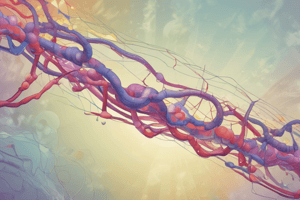Podcast
Questions and Answers
What is the primary function of COX-1 in the stomach?
What is the primary function of COX-1 in the stomach?
- Producing TXA2 to induce platelet aggregation
- Producing PGH2 to stimulate inflammation
- Producing PGE2 to provide a protective effect (correct)
- Producing PGI2 to prevent platelet aggregation
Which of the following NSAIDs is known to cause irreversible covalent modification?
Which of the following NSAIDs is known to cause irreversible covalent modification?
- Celecoxib
- Ibuprofen
- Flurbiprofen
- Aspirin (correct)
What is the primary mechanism of action of Paracetamol?
What is the primary mechanism of action of Paracetamol?
- Unknown, but it may involve multiple mechanisms (correct)
- Inhibition of COX-3 in the CNS
- Decrease in nitric oxide synthesis in the spinal cord
- Inhibition of COX-1 and COX-2
What is the main difference between COX-1 and COX-2 in terms of their structure?
What is the main difference between COX-1 and COX-2 in terms of their structure?
Which of the following is a potential side effect of NSAIDs?
Which of the following is a potential side effect of NSAIDs?
What is the main difference between COX-1 and COX-2 in terms of their expression?
What is the main difference between COX-1 and COX-2 in terms of their expression?
What is the primary function of the lipid mediators mentioned in the text?
What is the primary function of the lipid mediators mentioned in the text?
What is the target of NSAIDs according to the text?
What is the target of NSAIDs according to the text?
COX-1 is primarily found in the CNS and produces PGI2 to prevent platelet aggregation.
COX-1 is primarily found in the CNS and produces PGI2 to prevent platelet aggregation.
All NSAIDs are selective for COX-2.
All NSAIDs are selective for COX-2.
Paracetamol is an NSAID.
Paracetamol is an NSAID.
COX-2 is constitutively expressed and found in endothelial cells.
COX-2 is constitutively expressed and found in endothelial cells.
GI bleeding is a possible side effect of NSAIDs.
GI bleeding is a possible side effect of NSAIDs.
Rofecoxib is a non-selective NSAID.
Rofecoxib is a non-selective NSAID.
Cyclooxygenase is a pro-resolution lipid mediator.
Cyclooxygenase is a pro-resolution lipid mediator.
NSAIDs are selective inhibitors of COX-2.
NSAIDs are selective inhibitors of COX-2.
Flashcards are hidden until you start studying
Study Notes
Cyclooxygenase Enzyme
- Produces PGG2 and PGH2
- Has two subtypes: COX-1 and COX-2
COX-1 Subtype
- Constitutive and widespread
- Produces PGE2 in the stomach, which is protective
- Found in platelets, where it produces TXA2 for aggregation
- Has a small hydrophobic channel, which can be inhibited by small molecules
COX-2 Subtype
- Inducible, with synthesis increased by cytokines
- Produces high levels of PGs in areas of inflammation
- Found in endothelial cells, where it produces PGI2 to prevent aggregation, and in the CNS
- Has a larger channel, which can be inhibited by drugs with bulky side groups that cannot enter COX-1
NSAIDS (Non-steroidal Anti-inflammatory Drugs)
- Non-selective (COX-1 and COX-2) inhibitors:
- Aspirin (irreversible covalent modification)
- Ibuprofen (reversible)
- Ketorolac
- Flurbiprofen
- COX-2 selective (generally reversible) inhibitors:
- Celecoxib
- Rofecoxib
- Side effects: GI bleeding, possible increased cardiovascular risk
Paracetamol
- Not an anti-inflammatory drug
- Several proposed mechanisms of action, including:
- COX-3 in CNS
- Decrease nitrox oxide synthesis in spinal cord
- Metabolite NAPQI inhibiting neurotransmission
- Antipyretic analgesic, extremely safe and well-tolerated
- Given for a wide range of conditions
- Liver toxicity a concern
Studying That Suits You
Use AI to generate personalized quizzes and flashcards to suit your learning preferences.



